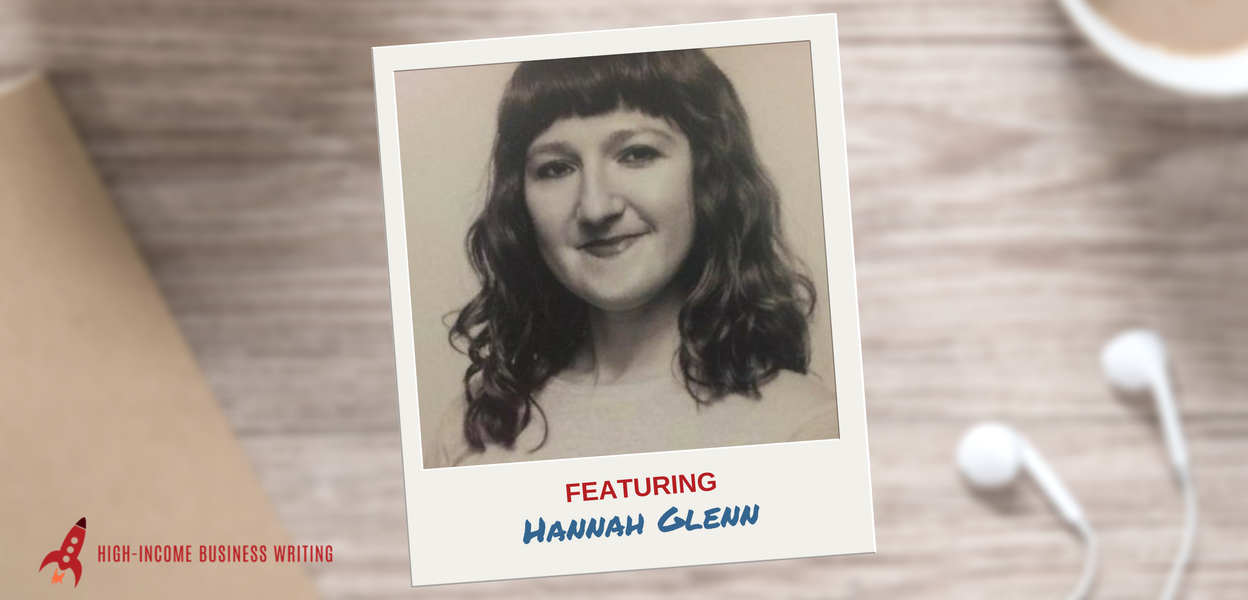This is another episode in our series on grit and its role in freelance success.
Check out the introductory episode here.
My guest this week, Hannah Glenn, is a model of grit.
She went through my B2B Biz Launcher 2.0 coaching program a while back. And she’s a perfect of example of someone who didn’t rely on luck to get ahead.
She had to work. And she had to work hard.
A few important points you’ll hear in this interview:
- You don’t necessarily need to have a previous career in a specific field in order to work in that field as a freelance writer or copywriter.
- You need to recognize and accept the fact that you will very likely pivot. You will make changes and adjustments to your positioning and your niche once you get out there—even if you spend months pre-planning.
- Steady and deliberate action are key. Serendipity only happens when you start taking action.
- Don’t have samples? Or may your samples are not that impressive? That’s OK, start where you are with what you’ve got! And get creative. Be resourceful!
- Warm email prospecting works! But you have to do it consistently. Don’t expect a massive win from sending out 10 emails.
- Set an effort goal every day.
- Focusing on baby steps and quick wins is essential to freelance success.
- Grit doesn’t mean working nonstop and sacrificing your health.
And much, much more. Enjoy!
The notes that follow are a very basic, unedited summary of the show. There’s a lot more detail in the audio version. You can listen to the show using the audio player below. Or you can subscribe in iTunes to get this show delivered straight to the Podcasts app on your smart phone, tablet or iPod.


High-Income Business Writing with Ed Gandia
#127: Hannah Glenn on Refining Your Niche as You Go, Taking Baby Steps to Success and the Power of Quick Wins
Tell us about yourself
Hannah Glenn creates written content for nonprofits, especially in healthcare. She also works with renewable energy companies.
What made you decide to go solo?
Hannah attended film school to study screenwriting. When she finished her film degree, she moved to L.A. There, she met with a recruiter and ended up working in talent management, PR and casting.
At the same time, she continued to take writing, marketing, blogging and SEO courses. She continued to dream of making a living as a writer. She started by freelance writing on the side and eventually moved into full-time freelancing.
Tell us how you picked your target market
Hannah has always been interested in health and wellness. When she developed food sensitivities, she launched her blog, Hollywood Snacktress.
When she started prospecting, Hannah reached to supplement suppliers and manufacturers. But it was hard to break through, and they didn’t pay well. However, she was able to get some samples out of it.
She came to realize she didn’t enjoy reading trade magazines in the supplements industry. But she did enjoy reading about renewable energy and nonprofits.
When she started, she didn’t know much about renewable energy, so she did a lot of research for her assignments. She found it fun and interesting.
Hannah also likes to support causes she believes in and help people live better lives. Ultimately, she found the entertainment industry wasn’t as fulfilling.
Is it possible to get past having no samples and a limited track record?
Not having any writing samples is a problem. Clients want to see evidence that you can write.
You can either create samples within your target market or create samples outside your target market that will still work inside your market.
(Ed started with some very basic and unimpressive samples. You can see them here.)
To generate samples for her health and wellness clients, Hannah created her own blog and wrote for free for Lifehack.
We discussed a similar strategy using “demonstration projects” in episode 114.
How did you prospect for clients?
Hannah’s number one prospecting method was warm email prospecting. If she can’t find an email address, and if the prospect looks promising, she will give them a call.
She tries to find something relevant to the prospect, so it’s not a form letter. Then she cuts to the chase and describes who she is and how she can help.
She likes to use the phrase “Does it make sense for us to connect?”
This approach puts prospects at ease. It’s not pushy.
End your warm emails with a question. It increases response.
Set a goal for yourself every day and have consistent follow up and tracking. Set aside at least 10 minutes a day to be calm and to breathe. Then work your butt off—but keep breathing!
How can we get over our fears about prospecting?
1. You have to believe in what you’re selling.
2. Understand that not everyone needs your services right now—and that’s okay. Accept that most people are going to say “no thanks” and respect that. You’re not trying to sell at any cost.
Many writers have an irrational fear that people are going to lash out or scold us if we approach them. But people are just busy doing their own thing. It’s not a personal rejection.
3. Take baby steps. Try for quick wins. And be sure to acknowledge your wins. Focus on the number of emails sent, not the number of replies. Remind yourself of the positive things that are happening.
What do you say when you call a prospect?
Cold calling prospects can be nerve racking.
Hannah says something along the lines of the following:
Hi, I’m an independent content writer, I specialize in ________. I was looking at your website and saw ____________. I’m just curious whether you ever work with outside writers and if you could use a hand right now?
I know sometimes companies get overwhelmed and can’t get everything done in house. Can I help?
If you want to talk, give me a call back. Here’s my number: __________________.
Hannah’s call script is similar to her warm email script, just less detailed.
If the prospect doesn’t pick up, she leaves a voicemail. Often, the prospect will call her back.
You say you learned how to find “creativity” in your prospecting. What do you mean by that?
Making connections between prospects and your own experiences or things you’ve read is a creative process. As Einstein said: Creativity is intelligence having fun.
Engaging your creative brain in approaching potential clients makes the process more fun. It also demonstrates your capacity for understanding.
Artisanal prospecting is different from most marketing. It’s handcrafted. It shows that you’ve done your homework, and that you’ve thought about the prospect and how to approach them.
How can listeners learn more about you?
Hannah’s food blog: Hollywood Snacktress
Writing website: Hannah Glenn Writer






